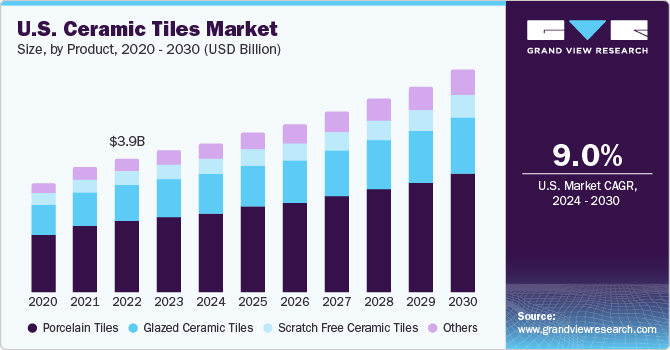Ceramic Tiles Market Trends: Innovations Shaping Design and Sustainability in 2024

The global ceramic tiles market was valued at approximately USD 186.70 billion in 2023 and is anticipated to experience a compound annual growth rate (CAGR) of 7.4% from 2024 to 2030. The increasing demand for aesthetically pleasing, durable wall and floor coverings, along with evolving consumer preferences in floor design, has significantly driven the growth of this market in recent years. Factors such as the expansion of offices and workspaces, enhancements in consumer lifestyles, and rapid urbanization have also played crucial roles in this upward trend. The high costs associated with property rehabilitation have created a strong demand for materials that offer longer lifespans and require minimal maintenance, which is expected to positively influence the market throughout the forecast period. The variety of colors, textures, and sizes available in ceramic tiles has further contributed to the growing appeal of this market segment.
Gather more insights about the market drivers, restrains and growth of the Global Ceramic Tiles Market
Regional Growth Drivers
The growth in construction spending across emerging economies in the Middle East and Asia Pacific can be linked to robust industrial and economic development coupled with population growth. This is likely to enhance the demand for ceramic tiles in these regions over the forecast period. Additionally, governments in these emerging markets have significantly invested in public infrastructure projects, including the construction of offices, hospitals, and housing developments, which further supports market growth.
In the United States, the ceramic wall tiles industry is projected to experience substantial growth due to the expansion of the construction sector. The increasing use of ceramic wall tiles in applications such as fireplace cladding and feature walls is a key factor driving this growth. In response to rising demand, industry players are actively launching new collections of wall tiles.
The favorable outlook for the healthcare sector in the U.S. is expected to boost demand for ceramic flooring solutions that are anti-bacterial, stain and water-resistant, low-maintenance, and highly durable. Additionally, shifting consumer preferences and the availability of decorative flooring options that enhance the aesthetics of commercial spaces, such as offices and business centers, are anticipated to further stimulate demand throughout the forecast period.
Segmentation Analysis:
Application Insights
In 2023, floor tiles accounted for the largest revenue share in the ceramic tiles market and remain the primary demand-driving segment. There is a noticeable shift among consumers moving away from traditional marble and stone flooring toward more affordable and maintenance-free ceramic tiles. Ceramic tiles are known for their stain resistance and long-lasting appearance. Technological advancements, particularly improvements in digital printing processes, are also contributing to increased industry demand. New printing technologies now offer features such as high resolution and multi-layer printing on various surface types, including flat, curved, or textured surfaces.
Moreover, ceramic wall tiles are increasingly being utilized in new residential applications such as halls, lobbies, and bedrooms. These tiles are also gaining traction as a cost-effective alternative to traditional stone materials in commercial settings, including corporate offices, hotel lobbies, and museums. Such trends are expected to significantly boost the overall demand for ceramic wall tiles globally during the forecast period.
End-use Insights
The commercial segment represented the largest revenue share in 2023, driven by rising demand for durable and cost-effective ceramic flooring in high-traffic commercial and industrial environments. The development of innovative products and simplified installation techniques has greatly contributed to the growth of the ceramic tiles industry. Furthermore, ceramic tiles are increasingly recognized as eco-friendly and economical solutions in various sectors, including healthcare, offices, educational institutions, and retail, thanks to their anti-bacterial, anti-slip, and water-resistant properties.
The growing preference for ceramic flooring among designers and architects is expected to enhance their demand in the commercial application segment in the coming years. Additionally, the expansion of modern offices and workspaces, ongoing renovation activities in commercial properties, and rapid industrialization in developing economies are all projected to propel the growth of the ceramic tiles industry throughout the forecast period.
Order a free sample PDF of the Ceramic Tiles Market Intelligence Study, published by Grand View Research.
- Art
- Causes
- Crafts
- Dance
- Drinks
- Film
- Fitness
- Food
- Oyunlar
- Gardening
- Health
- Home
- Literature
- Music
- Networking
- Other
- Party
- Religion
- Shopping
- Sports
- Theater
- Wellness
- IT, Cloud, Software and Technology


